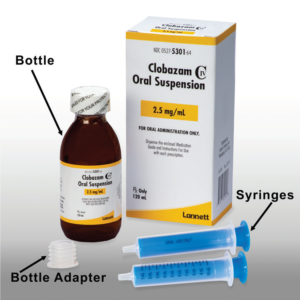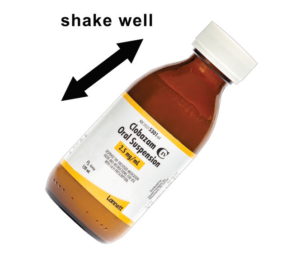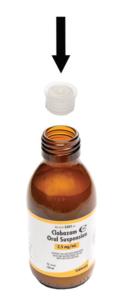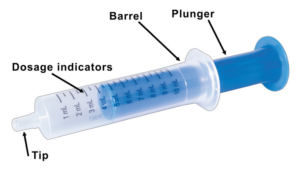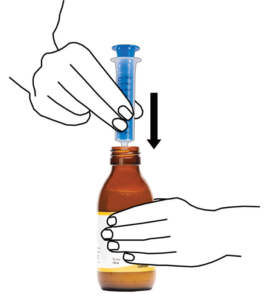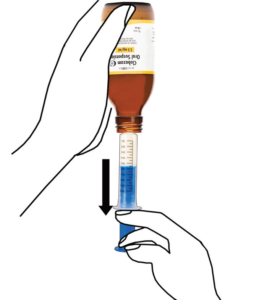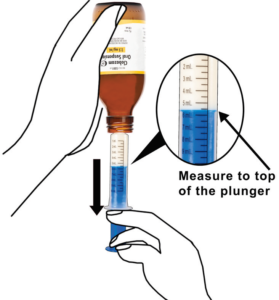MEDICATION GUIDE
Clobazam (kloe’ ba zam)
Oral Suspension, CIV
What is the most important information I should know about clobazam?
- Do not stop taking clobazam without first talking to your healthcare provider. Stopping clobazam suddenly can cause serious side effects.
- Clobazam is a benzodiazepine medicine. Benzodiazepines can cause severe drowsiness, breathing problems (respiratory depression), coma, and death when taken with opioid medicines.
- Clobazam can make you sleepy or dizzy and can slow your thinking and motor skills. This may get better over time.
- Do not drive, operate heavy machinery, or do other dangerous activities until you know how clobazam affects you.
- Clobazam may cause problems with your coordination, especially when you are walking or picking things up.
- Do not drink alcohol or take other drugs that may make you sleepy or dizzy while taking clobazam until you talk to your healthcare provider. When taken with alcohol or drugs that cause sleepiness or dizziness, clobazam may make your sleepiness or dizziness much worse.
- Clobazam can cause withdrawal symptoms.
- Do not stop taking clobazam all of a sudden without first talking to a healthcare provider. Stopping clobazam suddenly can cause seizures that will not stop (status epilepticus), hearing or seeing things that are not there (hallucinations), shaking, nervousness, and stomach and muscle cramps.
- Talk to your healthcare provider about slowly stopping clobazam to avoid withdrawal symptoms.
- Clobazam can be abused and cause dependence.
- Physical dependence is not the same as drug addiction. Your healthcare provider can tell you more about the differences between physical dependence and drug addiction.
- Clobazam is a federal controlled substance (CIV) because it can be abused or lead to dependence. Keep clobazam in a safe place to prevent misuse and abuse. Selling or giving away clobazam may harm others, and is against the law. Tell your healthcare provider if you have ever abused or been dependent on alcohol, prescription medicines or street drugs.
- Serious skin reactions have been seen when clobazam is taken with other medicines and may require stopping its use. Do not stop taking clobazam without first talking to your healthcare provider.
- A serious skin reaction can happen at any time during your treatment with clobazam, but is more likely to happen within the first 8 weeks of treatment. These skin reactions may need to be treated right away.
- Call your healthcare provider immediately if you have skin blisters, rash, sores in the mouth, hives or any other allergic reaction.
- Like other antiepileptic drugs, clobazam may cause suicidal thoughts or actions in a very small number of people, about 1 in 500.
Call your healthcare provider right away if you have any of these symptoms, especially if they are new, worse, or worry you:
- thoughts about suicide or dying
- new or worse anxiety
- trouble sleeping (insomnia)
- acting on dangerous impulses
- attempts to commit suicide
- feeling agitated or restless
- new or worse irritability
- an extreme increase in activity and talking (mania)
- new or worse depression
- panic attacks
- acting aggressive, being angry, or violent
- other unusual changes in behavior or mood
How can I watch for early symptoms of suicidal thoughts and actions?
- Pay attention to any changes, especially sudden changes, in mood, behaviors, thoughts, or feelings.
- Keep all follow-up visits with your healthcare provider as scheduled. Call your healthcare provider between visits as needed, especially if you are worried about symptoms. Suicidal thoughts or actions can be caused by things other than medicines. If you have suicidal thoughts or actions, your healthcare provider may check for other causes.
What is clobazam?
Clobazam is a prescription medicine used along with other medicines to treat seizures associated with Lennox-Gastaut syndrome in people 2 years of age or older. It is not known if clobazam is safe and effective in children less than 2 years old.
Do not take clobazam if you:
- are allergic to clobazam or any of the ingredients in clobazam. See the end of this Medication Guide for a complete list of ingredients in clobazam.
Before you take clobazam, tell your healthcare provider about all your medical conditions, including if you:
- have liver or kidney problems
- have lung problems (respiratory disease)
- have or have had depression, mood problems, or suicidal thoughts or behavior
- use birth control medicine. Clobazam may cause your birth control medicine to be less effective. Talk to your healthcare provider about the best birth control method to use.
- are pregnant or plan to become pregnant. Clobazam may harm your unborn baby.
- Tell your healthcare provider right away if you become pregnant while taking clobazam. You and your healthcare provider will decide if you should take clobazam while you are pregnant.
- Babies born to mothers receiving benzodiazepine medications (including clobazam) late in pregnancy may be at some risk of experiencing breathing problems, feeding problems, dangerously low body temperature, and withdrawal symptoms.
- If you become pregnant while taking clobazam, talk to your healthcare provider about registering with the North American Antiepileptic Drug Pregnancy Registry. You can register by calling 1-888-233-2334. For more information about the registry go to http://www.aedpregnancyregistry.org. The purpose of this registry is to collect information about the safety of antiepileptic drugs during pregnancy.
- Clobazam can pass into breast milk. Talk to your healthcare provider about the best way to feed your baby if you take clobazam. You and your healthcare provider should decide if you will take clobazam or breastfeed. You should not do both.
Tell your healthcare provider about all the medicines you take, including prescription and over-the-counter medicines, vitamins, and herbal supplements. Taking clobazam with certain other medicines can cause side effects or affect how well clobazam or the other medicines work. Do not start or stop other medicines without talking to your healthcare provider.
How should I take clobazam?
- Take clobazam exactly as your healthcare provider tells you to take it.
- Your healthcare provider will tell you how much clobazam to take and when to take it.
- Clobazam oral suspension can be taken with or without food.
- Shake the bottle of clobazam oral suspension right before you take each dose.
- Measure your dose of clobazam oral suspension using the bottle adapter and dosing syringes that come with your clobazam oral suspension.
- Read the Instructions for Use at the end of this Medication Guide for information on the right way to use clobazam oral suspension.
- Your healthcare provider may change your dose if needed. Do not change your dose of clobazam without talking to your healthcare provider.
- Do not stop taking clobazam without first talking to your healthcare provider.
- Stopping clobazam suddenly can cause serious problems.
- If you take too much clobazam, call your healthcare provider or go to the nearest hospital emergency room right away.
What should I avoid while taking clobazam?
- Do not drive, operate heavy machinery, or do other dangerous activities until you know how clobazam affects you.
- Do not drink alcohol or take other medicines that may make you sleepy or dizzy while taking clobazam until you talk to your healthcare provider. When taken with alcohol or medicines that cause sleepiness or dizziness, clobazam may make your sleepiness or dizziness much worse.
What are the possible side effects of clobazam?
Clobazam may cause serious side effects, including: See “What is the most important information I should know about clobazam?”
The most common side effects of clobazam include:
- sleepiness
- cough
- acting aggressive, being angry, or violent
- tiredness
- drooling
- pain with urination
- difficulty sleeping
- problems with breathing
- constipation
- fever
- slurred speech
These are not all the possible side effects of clobazam. Call your doctor for medical advice about side effects. You may report side effects to FDA at 1-800-FDA-1088.
How should I store clobazam?
- Store clobazam oral suspension between 68°F to 77°F (20°C to 25°C).
Oral Suspension
- Replace the cap securely after opening.
- Store and dispense the oral suspension in its original bottle in an upright position. Use clobazam oral suspension within 90 days of first opening the bottle.
- After 90 days safely throw away any clobazam oral suspension that has not been used.
- Keep clobazam and all medicines out of the reach of children.
General information about the safe and effective use of clobazam.
Medicines are sometimes prescribed for purposes other than those listed in a Medication Guide. Do not use clobazam for a condition for which it was not prescribed. Do not give clobazam to other people, even if they have the same symptoms that you have. It may harm them. You can ask your pharmacist or healthcare provider for information about clobazam that is written for health professionals.
What are the ingredients in clobazam?
Oral Suspension
Active ingredient: clobazam
Inactive ingredients: citric acid anhydrous, disodium phosphate anhydrous, magnesium aluminum silicate, maltitol solution, methylparaben, polysorbate 80, propylene glycol, propylparaben, purified water, simethicone emulsion, sucralose, xanthan gum and artificial blueberry flavor.
Distributed by: Lannett Company, Inc., Philadelphia, PA 19136
For more information about clobazam, go to www.lannett.com or call Lannett at 1-844-834-0530.
This Medication Guide has been approved by the U.S. Food and Drug Administration.
10-1198
Rev. 04/2020
Instructions for Use
Clobazam (kloe’ ba zam)
Oral Suspension, CIV
Read this Instructions for Use before using clobazam oral suspension and each time you get a refill. There may be new information. This leaflet does not take the place of talking with your healthcare provider about your medical condition or treatment.
Prepare Clobazam Oral Suspension Dose
You will need the following supplies: See Figure A
- Clobazam oral suspension bottle
- Bottle adapter
- Oral dosing syringe (2 dosing syringes are included in the clobazam oral suspension box).
- Use only 1 syringe to take your dose of clobazam oral suspension. If you lose or damage the syringe, or cannot read the markings, use the other syringe.
Figure A
Step 1. Remove the clobazam oral suspension bottle, bottle adapter, and 1 syringe from the box.
Step 2. Shake the bottle well before each use. See Figure B
Figure B
Step 3. Uncap the bottle and firmly insert the bottle adapter into the bottle until the adapter top is even with the bottle top. See Figure C
Figure C
Once the bottle adapter is in place, it should not be removed.
Step 4. Check your dose in milliliters (mL) as prescribed by your healthcare provider. Find this number on the syringe. Do not take more than the prescribed total dose in 1 day. See Figure D
Figure D
Step 5. Push the plunger all the way down and then insert the syringe into the upright bottle through the opening in the bottle adapter. See Figure E
Figure E
Step 6. With the syringe in place, turn the bottle upside down. Pull the plunger to the number of mLs needed (the amount of liquid medicine in Step 4). See Figure F
Figure F
Measure the mLs of medicine using the top of the plunger on the blue plunger. See Figure G
Figure G
Step 7. Remove the syringe from the bottle adapter. Slowly squirt clobazam oral suspension directly into the corner of your mouth or your child’s mouth until all of the liquid medicine in the syringe is given. See Figure H
Figure H
Step 8. Cap the bottle tightly with the adapter in place. If the cap does not fit securely, check to see if the adapter is fully inserted. See Figure I
- Store and dispense clobazam oral suspension in its original bottle in an upright position at 68°F to 77°F (20°C to 25°C).
- Use clobazam oral suspension within 90 days of first opening bottle.
- After 90 days safely throw away any clobazam oral suspension that has not been used.
Figure I
Step 9. Wash the oral syringe after each use.
- To clean the oral syringe, take apart by removing the plunger completely. Pull plunger straight out of the barrel.
- The barrel and plunger can be washed with soap and water, rinsed, and allowed to dry.
- Do not wash the oral syringe in the dishwasher.
This Instruction for Use has been approved by the U.S. Food and Drug Administration.
Distributed by:
Lannett Company, Inc.
Philadelphia, PA 19136
All brand names are the trademarks of their respective owners.

